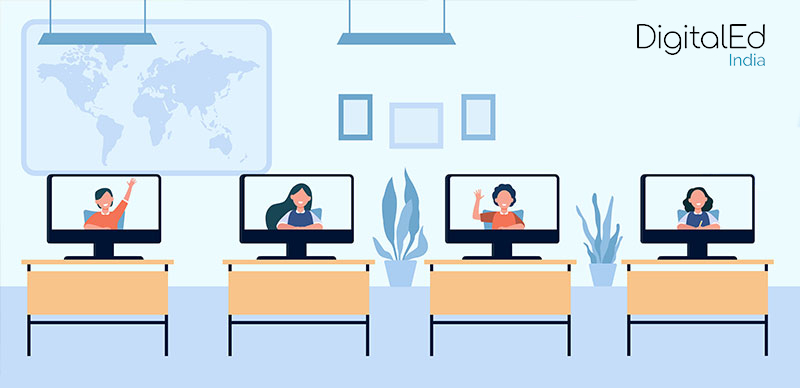Has COVID-19 shifted education in India to flip learning?

Introduction
The covid- 19 outbreak will be remembered for a long time as “the time everything changed.” The pandemic transformed every aspect of our day-to-day lives, from how we lived to how we learned. It affected students and teachers across 150,000 schools, 1,028 universities, 41,901 colleges, and 10,726 standalone institutes. Among the many changes, one significant shift was the rise of flipped learning, where students engaged with study materials at home and used class time for discussion and problem-solving. This approach emerged as a powerful alternative to traditional teaching methods, helping educators adapt to the challenges of remote and hybrid learning
This proves to be a new challenge for both teachers and students. Many teachers and institutions have initiated teaching virtually through online platforms like youtube, zoom, etc. but our traditional methods of Fixed Classroom and in-person teaching have left a lot of students and teachers in a stumble.
These platforms have been very helpful for students to learn since the initial lockdown in March 2020. But the inefficiency of these media and business meeting platforms has raised the demand for a change in a learning model that aligns with today’s learning needs.
Some features that video-conferencing softwares lack for efficient online learning:
- Teachers should be able to use teaching tools like PowerPoint presentations and virtual whiteboards to share additional learning materials.
- Platforms must offer features to post reminders, assign homework, and conduct tests—serving as a central hub for all learning content.
- Effective two-way communication should go beyond a basic “raise hand” button. There must be robust tools to clear doubts and interact outside scheduled calls.
- A system to track students’ progress, with real-time analytics and storage of all submissions, is essential.
It’s time educational institutions in India started accepting the challenges and adjusting to the new normal of the pandemic-hit 21st century.
What exactly is the Flipped Classroom and Flipped Teaching Model?
Blended learning or hybrid learning is the method of teaching in which a student learns through both offline and online forms of schooling. The concept of blended learning involves the integration of technology with digital learning where instructor-led classes are provided to students through digital technologies.
The flipped teaching model is a type of blended teaching model where students are introduced to educational content through online(video lectures) or offline(books) resources at home and practice working through it at school.
A flipped classroom is one where students review the study materials before class as self-paced study. The in-class teacher time is devoted to discussing the study material with help of group discussions, engaging exercises, and interactive activities all under the guidance of the teacher. This gives students an interactive and knowledge-friendly platform to acknowledge their curiosity and outgrow their potential.
Flipped Classrooms: The future of the Indian Education System
Through Flipped teaching model, approximately 320 million students in India alone will be able to access an education system that doesn’t end at the last bell of school. This modern approach to education gives students a knowledge-friendly environment without the pressure of a formal classroom. Moreover, with timely execution of exams and co-curricular activities, it ensures time discipline and continuous evaluation.
Advantages of Flipped Teaching Model:
● Self-Paced Education: Since the mode of study is online and flexible, students get to learn at their desired speed.
● Interactive Education: Flipped Learning encourages engaging activities and live discussions on study materials making it way more interactive compared to traditional teaching models.
● Up to Date Knowledge: With online classes and study materials, students can know the latest findings and understand concepts through various sources without getting outpaced by the advancement of technology and industry demand.
● Student-Centered Education: The most significant feature of Flipped Learning Model is a customized and student-centered curriculum that allows every student to approach the syllabus in their unique way.
The Role of Mobius in Flipped Learning
Here, Mobius is crucial to enabling the flipped classroom model. Mobius offers a powerful digital learning platform designed specifically for STEM education, providing dynamic assessments, interactive lessons, and personalized learning paths. It allows educators to easily create and share rich, engaging course content while tracking student performance in real time.
With Mobius, students can learn complex mathematical and scientific concepts through simulations and visual tools—even before attending class. This prepares them for deeper engagement and active problem-solving during classroom sessions, perfectly aligning with the flipped model’s goals.
Final Thoughts:
One thing the COVID-19 outbreak proved is that change is inevitable—and it can happen at any time. While we can’t stop these changes, we can be prepared for them. Flipped classrooms may come with technological and adaptation challenges, but they are essential to providing uninterrupted, meaningful education.
Mobius helps bridge the gap between traditional methods and the future of learning, making education more resilient, accessible, and engaging. The path forward lies in transforming our classrooms and embracing models that equip students for the world ahead—by flipping the old to make way for the new.
Ready to experience how Mobius can support flipped learning? Book a Möbius demo today!